MKT3SEM - Social Marketing: A Comprehensive Cyberbullying Plan
VerifiedAdded on 2023/06/14
|8
|2217
|453
Report
AI Summary
This report addresses the growing social issue of cyberbullying and proposes a social marketing plan to combat it. It begins with a literature review, highlighting the emotional and psychological impact of cyberbullying on youth and the increasing prevalence due to social media. The proposed social marketing plan involves creating a culture of awareness in schools and homes, launching government campaigns, teaching kids to report bullying, and developing effective intervention programs. The plan emphasizes digital citizenship, parental involvement, and the implementation of legal implications to address cyberbullying. It also includes monitoring cyber activities and providing avenues for reporting incidents. The report concludes by underscoring the importance of guiding teenagers in staying safe online and fostering positive social media use.

Social marketing
Paraphrase This Document
Need a fresh take? Get an instant paraphrase of this document with our AI Paraphraser
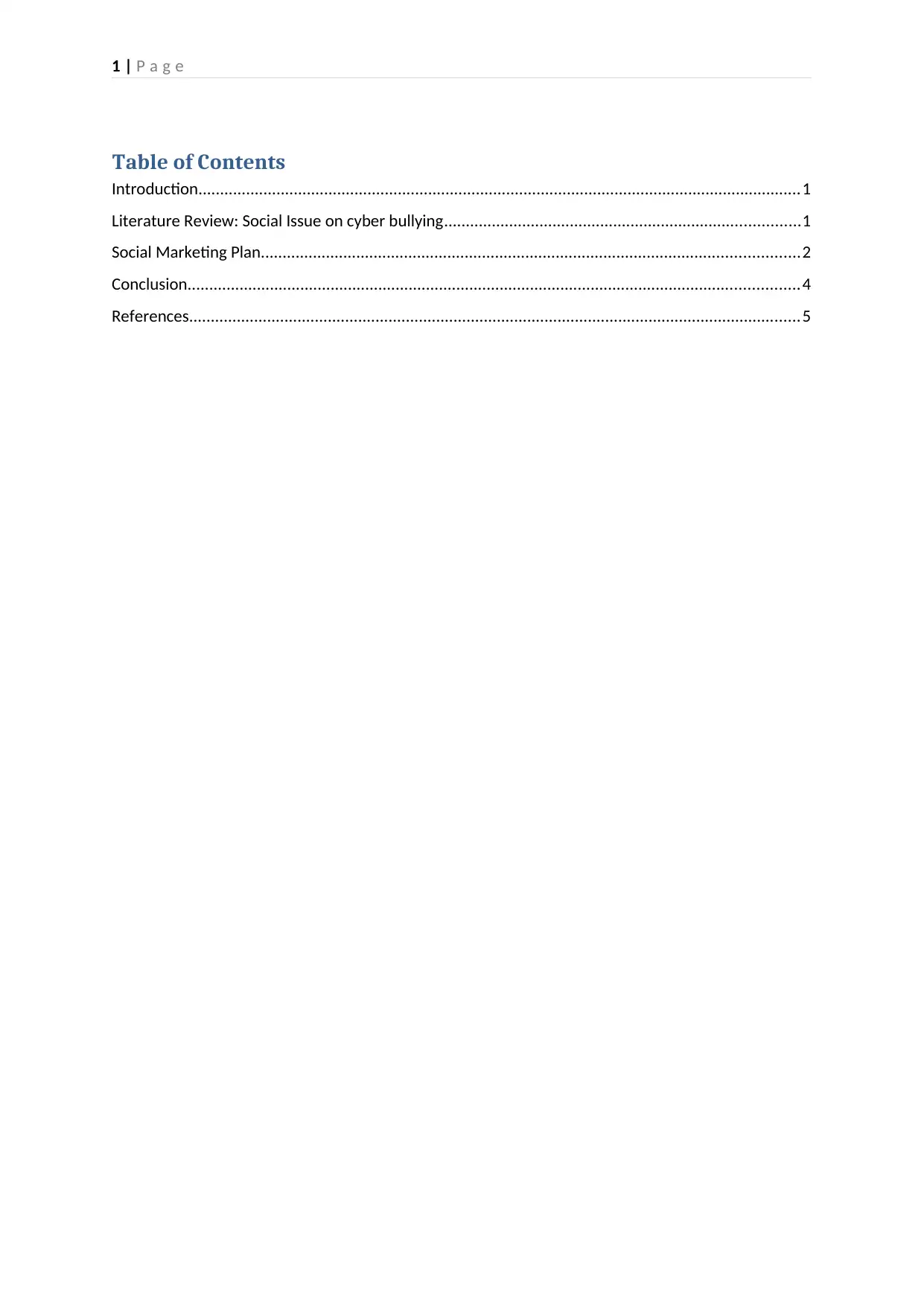
1 | P a g e
Table of Contents
Introduction...........................................................................................................................................1
Literature Review: Social Issue on cyber bullying..................................................................................1
Social Marketing Plan............................................................................................................................2
Conclusion.............................................................................................................................................4
References.............................................................................................................................................5
Table of Contents
Introduction...........................................................................................................................................1
Literature Review: Social Issue on cyber bullying..................................................................................1
Social Marketing Plan............................................................................................................................2
Conclusion.............................................................................................................................................4
References.............................................................................................................................................5
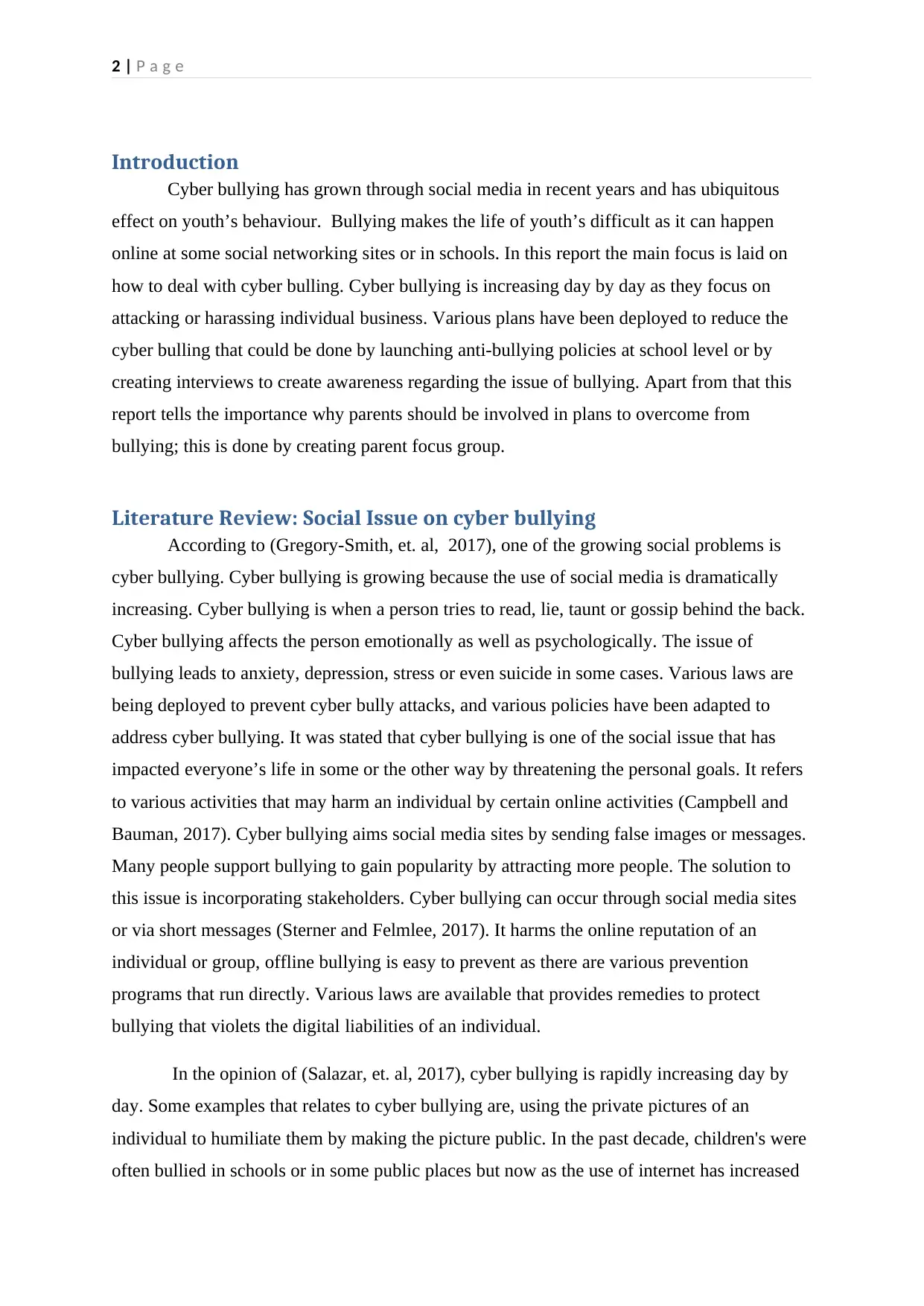
2 | P a g e
Introduction
Cyber bullying has grown through social media in recent years and has ubiquitous
effect on youth’s behaviour. Bullying makes the life of youth’s difficult as it can happen
online at some social networking sites or in schools. In this report the main focus is laid on
how to deal with cyber bulling. Cyber bullying is increasing day by day as they focus on
attacking or harassing individual business. Various plans have been deployed to reduce the
cyber bulling that could be done by launching anti-bullying policies at school level or by
creating interviews to create awareness regarding the issue of bullying. Apart from that this
report tells the importance why parents should be involved in plans to overcome from
bullying; this is done by creating parent focus group.
Literature Review: Social Issue on cyber bullying
According to (Gregory-Smith, et. al, 2017), one of the growing social problems is
cyber bullying. Cyber bullying is growing because the use of social media is dramatically
increasing. Cyber bullying is when a person tries to read, lie, taunt or gossip behind the back.
Cyber bullying affects the person emotionally as well as psychologically. The issue of
bullying leads to anxiety, depression, stress or even suicide in some cases. Various laws are
being deployed to prevent cyber bully attacks, and various policies have been adapted to
address cyber bullying. It was stated that cyber bullying is one of the social issue that has
impacted everyone’s life in some or the other way by threatening the personal goals. It refers
to various activities that may harm an individual by certain online activities (Campbell and
Bauman, 2017). Cyber bullying aims social media sites by sending false images or messages.
Many people support bullying to gain popularity by attracting more people. The solution to
this issue is incorporating stakeholders. Cyber bullying can occur through social media sites
or via short messages (Sterner and Felmlee, 2017). It harms the online reputation of an
individual or group, offline bullying is easy to prevent as there are various prevention
programs that run directly. Various laws are available that provides remedies to protect
bullying that violets the digital liabilities of an individual.
In the opinion of (Salazar, et. al, 2017), cyber bullying is rapidly increasing day by
day. Some examples that relates to cyber bullying are, using the private pictures of an
individual to humiliate them by making the picture public. In the past decade, children's were
often bullied in schools or in some public places but now as the use of internet has increased
Introduction
Cyber bullying has grown through social media in recent years and has ubiquitous
effect on youth’s behaviour. Bullying makes the life of youth’s difficult as it can happen
online at some social networking sites or in schools. In this report the main focus is laid on
how to deal with cyber bulling. Cyber bullying is increasing day by day as they focus on
attacking or harassing individual business. Various plans have been deployed to reduce the
cyber bulling that could be done by launching anti-bullying policies at school level or by
creating interviews to create awareness regarding the issue of bullying. Apart from that this
report tells the importance why parents should be involved in plans to overcome from
bullying; this is done by creating parent focus group.
Literature Review: Social Issue on cyber bullying
According to (Gregory-Smith, et. al, 2017), one of the growing social problems is
cyber bullying. Cyber bullying is growing because the use of social media is dramatically
increasing. Cyber bullying is when a person tries to read, lie, taunt or gossip behind the back.
Cyber bullying affects the person emotionally as well as psychologically. The issue of
bullying leads to anxiety, depression, stress or even suicide in some cases. Various laws are
being deployed to prevent cyber bully attacks, and various policies have been adapted to
address cyber bullying. It was stated that cyber bullying is one of the social issue that has
impacted everyone’s life in some or the other way by threatening the personal goals. It refers
to various activities that may harm an individual by certain online activities (Campbell and
Bauman, 2017). Cyber bullying aims social media sites by sending false images or messages.
Many people support bullying to gain popularity by attracting more people. The solution to
this issue is incorporating stakeholders. Cyber bullying can occur through social media sites
or via short messages (Sterner and Felmlee, 2017). It harms the online reputation of an
individual or group, offline bullying is easy to prevent as there are various prevention
programs that run directly. Various laws are available that provides remedies to protect
bullying that violets the digital liabilities of an individual.
In the opinion of (Salazar, et. al, 2017), cyber bullying is rapidly increasing day by
day. Some examples that relates to cyber bullying are, using the private pictures of an
individual to humiliate them by making the picture public. In the past decade, children's were
often bullied in schools or in some public places but now as the use of internet has increased
⊘ This is a preview!⊘
Do you want full access?
Subscribe today to unlock all pages.

Trusted by 1+ million students worldwide
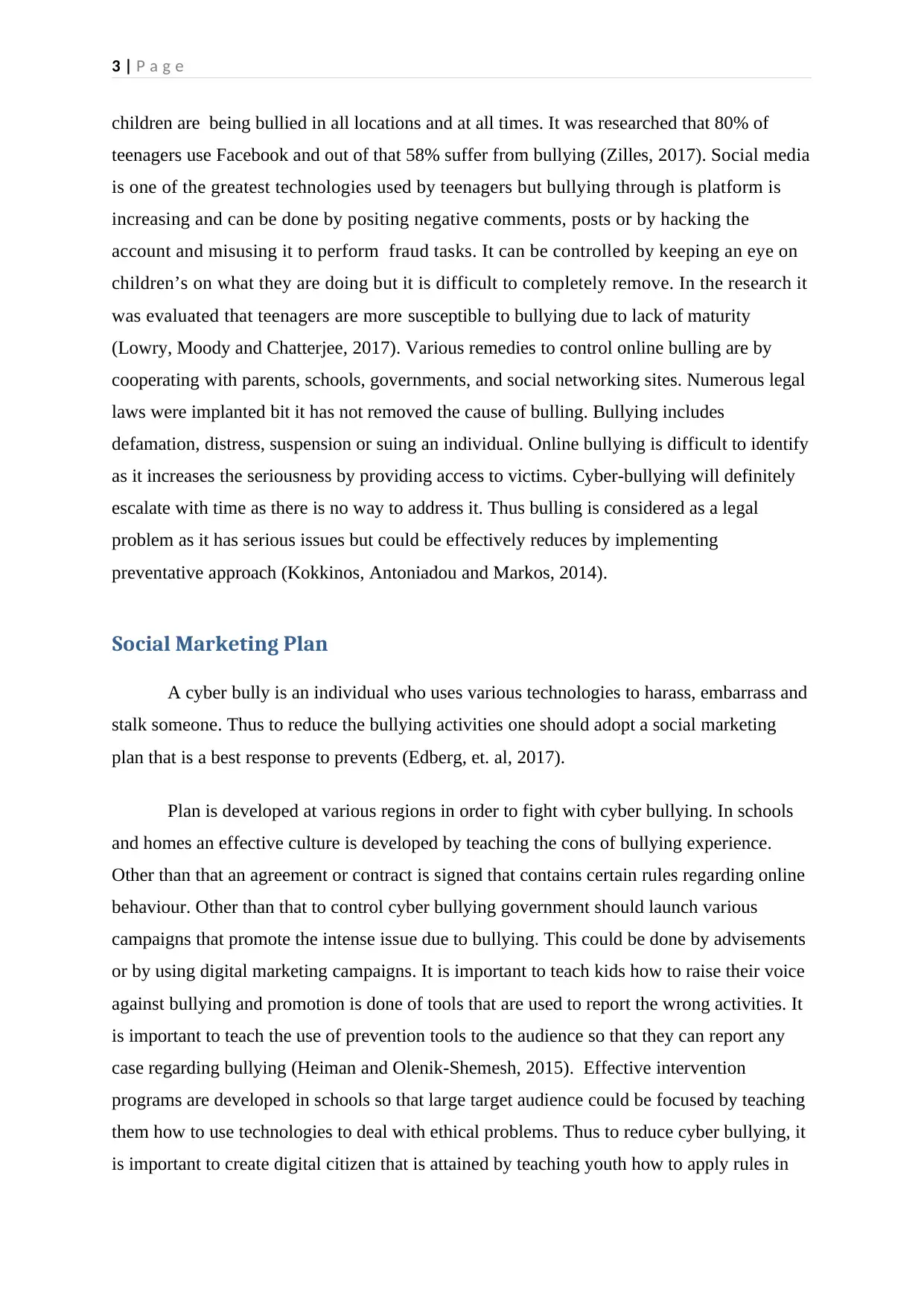
3 | P a g e
children are being bullied in all locations and at all times. It was researched that 80% of
teenagers use Facebook and out of that 58% suffer from bullying (Zilles, 2017). Social media
is one of the greatest technologies used by teenagers but bullying through is platform is
increasing and can be done by positing negative comments, posts or by hacking the
account and misusing it to perform fraud tasks. It can be controlled by keeping an eye on
children’s on what they are doing but it is difficult to completely remove. In the research it
was evaluated that teenagers are more susceptible to bullying due to lack of maturity
(Lowry, Moody and Chatterjee, 2017). Various remedies to control online bulling are by
cooperating with parents, schools, governments, and social networking sites. Numerous legal
laws were implanted bit it has not removed the cause of bulling. Bullying includes
defamation, distress, suspension or suing an individual. Online bullying is difficult to identify
as it increases the seriousness by providing access to victims. Cyber-bullying will definitely
escalate with time as there is no way to address it. Thus bulling is considered as a legal
problem as it has serious issues but could be effectively reduces by implementing
preventative approach (Kokkinos, Antoniadou and Markos, 2014).
Social Marketing Plan
A cyber bully is an individual who uses various technologies to harass, embarrass and
stalk someone. Thus to reduce the bullying activities one should adopt a social marketing
plan that is a best response to prevents (Edberg, et. al, 2017).
Plan is developed at various regions in order to fight with cyber bullying. In schools
and homes an effective culture is developed by teaching the cons of bullying experience.
Other than that an agreement or contract is signed that contains certain rules regarding online
behaviour. Other than that to control cyber bullying government should launch various
campaigns that promote the intense issue due to bullying. This could be done by advisements
or by using digital marketing campaigns. It is important to teach kids how to raise their voice
against bullying and promotion is done of tools that are used to report the wrong activities. It
is important to teach the use of prevention tools to the audience so that they can report any
case regarding bullying (Heiman and Olenik-Shemesh, 2015). Effective intervention
programs are developed in schools so that large target audience could be focused by teaching
them how to use technologies to deal with ethical problems. Thus to reduce cyber bullying, it
is important to create digital citizen that is attained by teaching youth how to apply rules in
children are being bullied in all locations and at all times. It was researched that 80% of
teenagers use Facebook and out of that 58% suffer from bullying (Zilles, 2017). Social media
is one of the greatest technologies used by teenagers but bullying through is platform is
increasing and can be done by positing negative comments, posts or by hacking the
account and misusing it to perform fraud tasks. It can be controlled by keeping an eye on
children’s on what they are doing but it is difficult to completely remove. In the research it
was evaluated that teenagers are more susceptible to bullying due to lack of maturity
(Lowry, Moody and Chatterjee, 2017). Various remedies to control online bulling are by
cooperating with parents, schools, governments, and social networking sites. Numerous legal
laws were implanted bit it has not removed the cause of bulling. Bullying includes
defamation, distress, suspension or suing an individual. Online bullying is difficult to identify
as it increases the seriousness by providing access to victims. Cyber-bullying will definitely
escalate with time as there is no way to address it. Thus bulling is considered as a legal
problem as it has serious issues but could be effectively reduces by implementing
preventative approach (Kokkinos, Antoniadou and Markos, 2014).
Social Marketing Plan
A cyber bully is an individual who uses various technologies to harass, embarrass and
stalk someone. Thus to reduce the bullying activities one should adopt a social marketing
plan that is a best response to prevents (Edberg, et. al, 2017).
Plan is developed at various regions in order to fight with cyber bullying. In schools
and homes an effective culture is developed by teaching the cons of bullying experience.
Other than that an agreement or contract is signed that contains certain rules regarding online
behaviour. Other than that to control cyber bullying government should launch various
campaigns that promote the intense issue due to bullying. This could be done by advisements
or by using digital marketing campaigns. It is important to teach kids how to raise their voice
against bullying and promotion is done of tools that are used to report the wrong activities. It
is important to teach the use of prevention tools to the audience so that they can report any
case regarding bullying (Heiman and Olenik-Shemesh, 2015). Effective intervention
programs are developed in schools so that large target audience could be focused by teaching
them how to use technologies to deal with ethical problems. Thus to reduce cyber bullying, it
is important to create digital citizen that is attained by teaching youth how to apply rules in
Paraphrase This Document
Need a fresh take? Get an instant paraphrase of this document with our AI Paraphraser
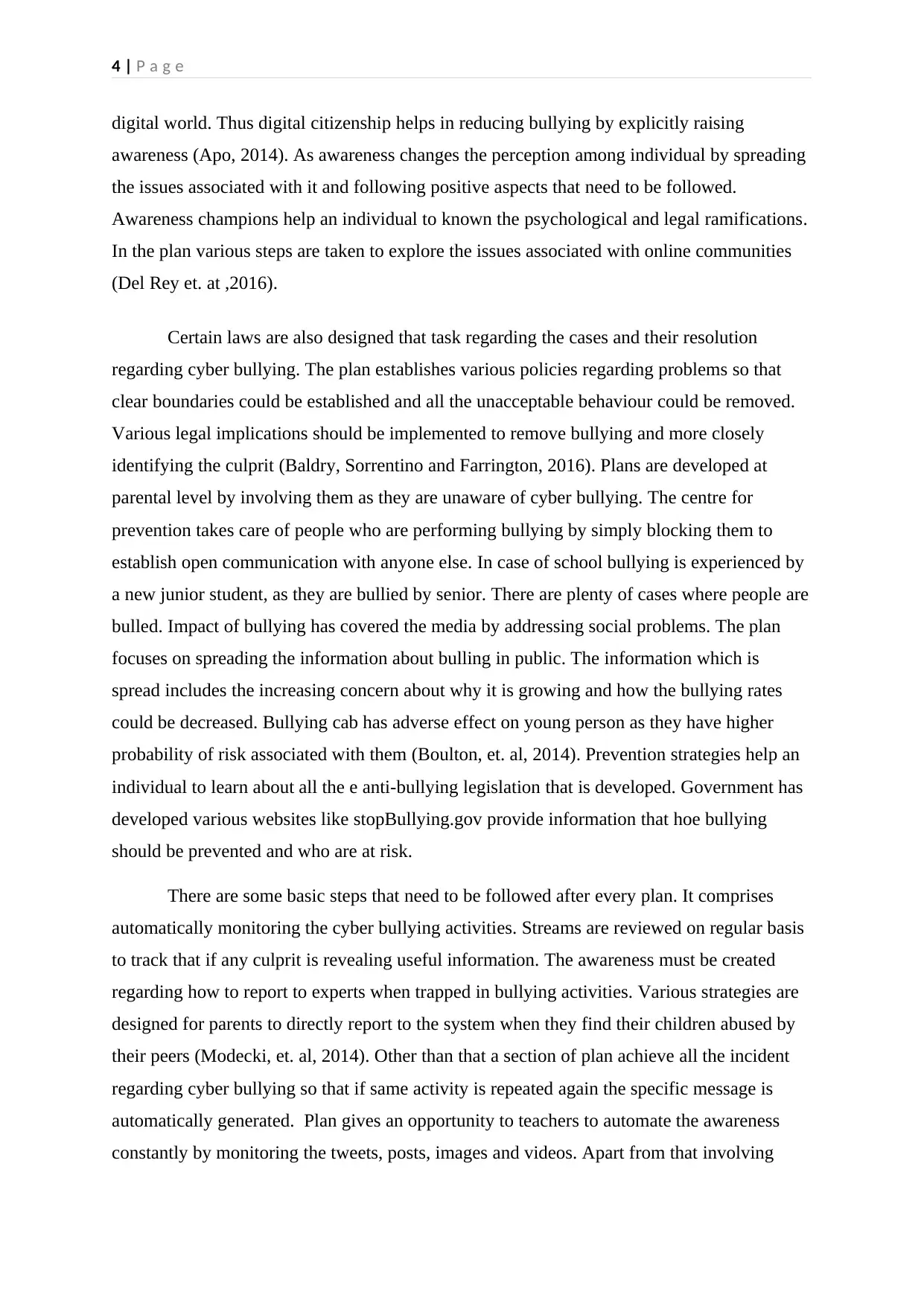
4 | P a g e
digital world. Thus digital citizenship helps in reducing bullying by explicitly raising
awareness (Apo, 2014). As awareness changes the perception among individual by spreading
the issues associated with it and following positive aspects that need to be followed.
Awareness champions help an individual to known the psychological and legal ramifications.
In the plan various steps are taken to explore the issues associated with online communities
(Del Rey et. at ,2016).
Certain laws are also designed that task regarding the cases and their resolution
regarding cyber bullying. The plan establishes various policies regarding problems so that
clear boundaries could be established and all the unacceptable behaviour could be removed.
Various legal implications should be implemented to remove bullying and more closely
identifying the culprit (Baldry, Sorrentino and Farrington, 2016). Plans are developed at
parental level by involving them as they are unaware of cyber bullying. The centre for
prevention takes care of people who are performing bullying by simply blocking them to
establish open communication with anyone else. In case of school bullying is experienced by
a new junior student, as they are bullied by senior. There are plenty of cases where people are
bulled. Impact of bullying has covered the media by addressing social problems. The plan
focuses on spreading the information about bulling in public. The information which is
spread includes the increasing concern about why it is growing and how the bullying rates
could be decreased. Bullying cab has adverse effect on young person as they have higher
probability of risk associated with them (Boulton, et. al, 2014). Prevention strategies help an
individual to learn about all the e anti-bullying legislation that is developed. Government has
developed various websites like stopBullying.gov provide information that hoe bullying
should be prevented and who are at risk.
There are some basic steps that need to be followed after every plan. It comprises
automatically monitoring the cyber bullying activities. Streams are reviewed on regular basis
to track that if any culprit is revealing useful information. The awareness must be created
regarding how to report to experts when trapped in bullying activities. Various strategies are
designed for parents to directly report to the system when they find their children abused by
their peers (Modecki, et. al, 2014). Other than that a section of plan achieve all the incident
regarding cyber bullying so that if same activity is repeated again the specific message is
automatically generated. Plan gives an opportunity to teachers to automate the awareness
constantly by monitoring the tweets, posts, images and videos. Apart from that involving
digital world. Thus digital citizenship helps in reducing bullying by explicitly raising
awareness (Apo, 2014). As awareness changes the perception among individual by spreading
the issues associated with it and following positive aspects that need to be followed.
Awareness champions help an individual to known the psychological and legal ramifications.
In the plan various steps are taken to explore the issues associated with online communities
(Del Rey et. at ,2016).
Certain laws are also designed that task regarding the cases and their resolution
regarding cyber bullying. The plan establishes various policies regarding problems so that
clear boundaries could be established and all the unacceptable behaviour could be removed.
Various legal implications should be implemented to remove bullying and more closely
identifying the culprit (Baldry, Sorrentino and Farrington, 2016). Plans are developed at
parental level by involving them as they are unaware of cyber bullying. The centre for
prevention takes care of people who are performing bullying by simply blocking them to
establish open communication with anyone else. In case of school bullying is experienced by
a new junior student, as they are bullied by senior. There are plenty of cases where people are
bulled. Impact of bullying has covered the media by addressing social problems. The plan
focuses on spreading the information about bulling in public. The information which is
spread includes the increasing concern about why it is growing and how the bullying rates
could be decreased. Bullying cab has adverse effect on young person as they have higher
probability of risk associated with them (Boulton, et. al, 2014). Prevention strategies help an
individual to learn about all the e anti-bullying legislation that is developed. Government has
developed various websites like stopBullying.gov provide information that hoe bullying
should be prevented and who are at risk.
There are some basic steps that need to be followed after every plan. It comprises
automatically monitoring the cyber bullying activities. Streams are reviewed on regular basis
to track that if any culprit is revealing useful information. The awareness must be created
regarding how to report to experts when trapped in bullying activities. Various strategies are
designed for parents to directly report to the system when they find their children abused by
their peers (Modecki, et. al, 2014). Other than that a section of plan achieve all the incident
regarding cyber bullying so that if same activity is repeated again the specific message is
automatically generated. Plan gives an opportunity to teachers to automate the awareness
constantly by monitoring the tweets, posts, images and videos. Apart from that involving
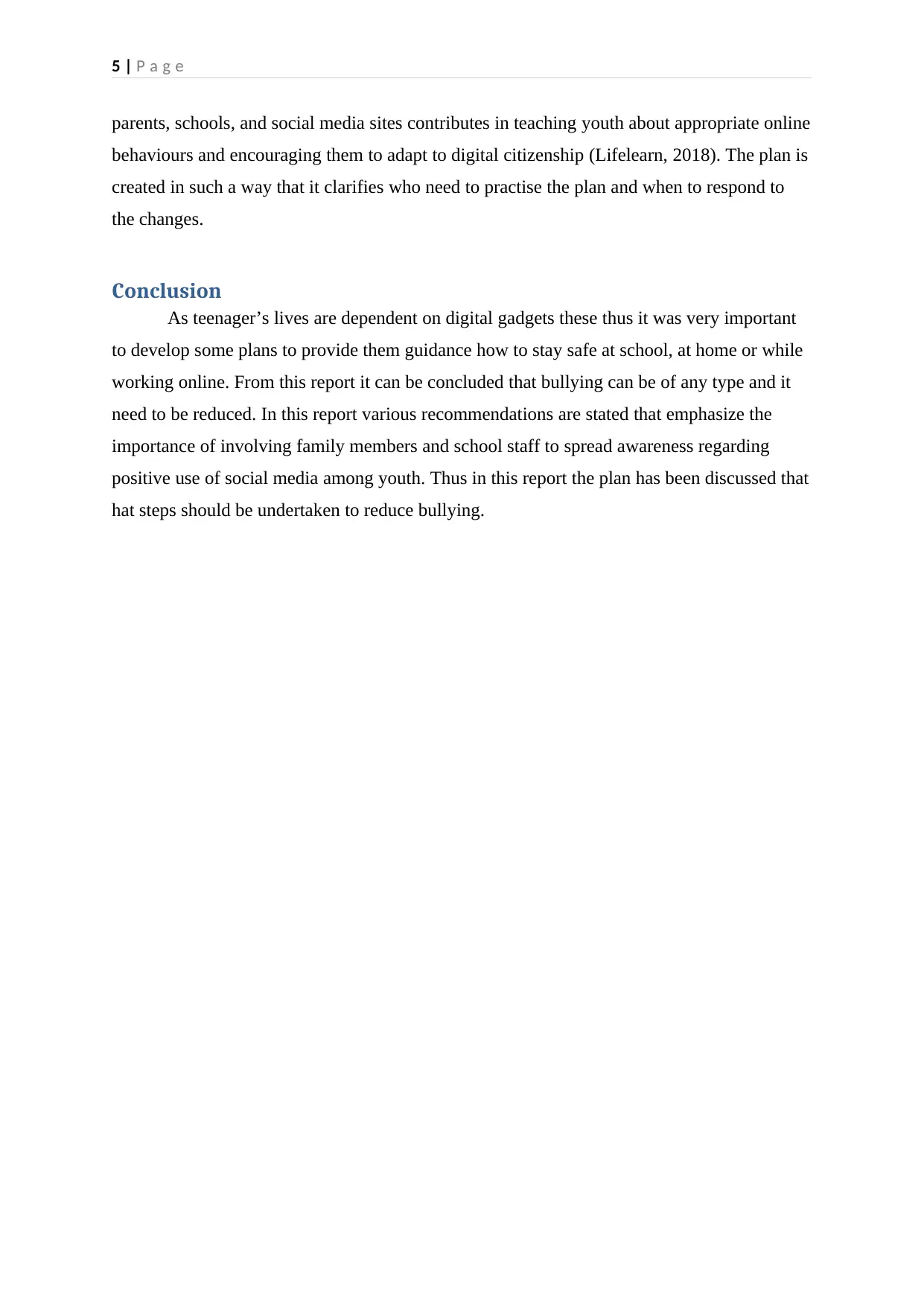
5 | P a g e
parents, schools, and social media sites contributes in teaching youth about appropriate online
behaviours and encouraging them to adapt to digital citizenship (Lifelearn, 2018). The plan is
created in such a way that it clarifies who need to practise the plan and when to respond to
the changes.
Conclusion
As teenager’s lives are dependent on digital gadgets these thus it was very important
to develop some plans to provide them guidance how to stay safe at school, at home or while
working online. From this report it can be concluded that bullying can be of any type and it
need to be reduced. In this report various recommendations are stated that emphasize the
importance of involving family members and school staff to spread awareness regarding
positive use of social media among youth. Thus in this report the plan has been discussed that
hat steps should be undertaken to reduce bullying.
parents, schools, and social media sites contributes in teaching youth about appropriate online
behaviours and encouraging them to adapt to digital citizenship (Lifelearn, 2018). The plan is
created in such a way that it clarifies who need to practise the plan and when to respond to
the changes.
Conclusion
As teenager’s lives are dependent on digital gadgets these thus it was very important
to develop some plans to provide them guidance how to stay safe at school, at home or while
working online. From this report it can be concluded that bullying can be of any type and it
need to be reduced. In this report various recommendations are stated that emphasize the
importance of involving family members and school staff to spread awareness regarding
positive use of social media among youth. Thus in this report the plan has been discussed that
hat steps should be undertaken to reduce bullying.
⊘ This is a preview!⊘
Do you want full access?
Subscribe today to unlock all pages.

Trusted by 1+ million students worldwide
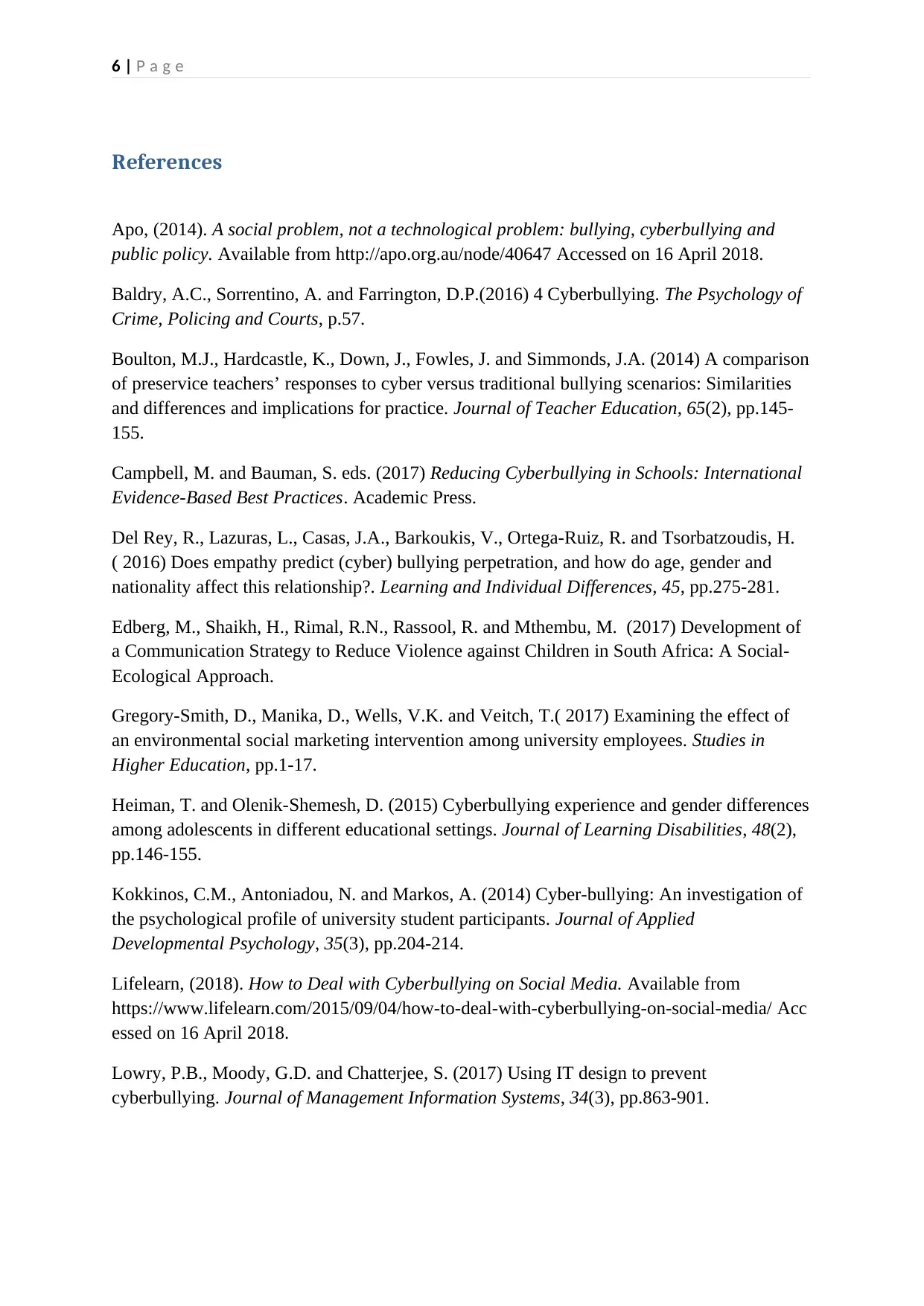
6 | P a g e
References
Apo, (2014). A social problem, not a technological problem: bullying, cyberbullying and
public policy. Available from http://apo.org.au/node/40647 Accessed on 16 April 2018.
Baldry, A.C., Sorrentino, A. and Farrington, D.P.(2016) 4 Cyberbullying. The Psychology of
Crime, Policing and Courts, p.57.
Boulton, M.J., Hardcastle, K., Down, J., Fowles, J. and Simmonds, J.A. (2014) A comparison
of preservice teachers’ responses to cyber versus traditional bullying scenarios: Similarities
and differences and implications for practice. Journal of Teacher Education, 65(2), pp.145-
155.
Campbell, M. and Bauman, S. eds. (2017) Reducing Cyberbullying in Schools: International
Evidence-Based Best Practices. Academic Press.
Del Rey, R., Lazuras, L., Casas, J.A., Barkoukis, V., Ortega-Ruiz, R. and Tsorbatzoudis, H.
( 2016) Does empathy predict (cyber) bullying perpetration, and how do age, gender and
nationality affect this relationship?. Learning and Individual Differences, 45, pp.275-281.
Edberg, M., Shaikh, H., Rimal, R.N., Rassool, R. and Mthembu, M. (2017) Development of
a Communication Strategy to Reduce Violence against Children in South Africa: A Social-
Ecological Approach.
Gregory-Smith, D., Manika, D., Wells, V.K. and Veitch, T.( 2017) Examining the effect of
an environmental social marketing intervention among university employees. Studies in
Higher Education, pp.1-17.
Heiman, T. and Olenik-Shemesh, D. (2015) Cyberbullying experience and gender differences
among adolescents in different educational settings. Journal of Learning Disabilities, 48(2),
pp.146-155.
Kokkinos, C.M., Antoniadou, N. and Markos, A. (2014) Cyber-bullying: An investigation of
the psychological profile of university student participants. Journal of Applied
Developmental Psychology, 35(3), pp.204-214.
Lifelearn, (2018). How to Deal with Cyberbullying on Social Media. Available from
https://www.lifelearn.com/2015/09/04/how-to-deal-with-cyberbullying-on-social-media/ Acc
essed on 16 April 2018.
Lowry, P.B., Moody, G.D. and Chatterjee, S. (2017) Using IT design to prevent
cyberbullying. Journal of Management Information Systems, 34(3), pp.863-901.
References
Apo, (2014). A social problem, not a technological problem: bullying, cyberbullying and
public policy. Available from http://apo.org.au/node/40647 Accessed on 16 April 2018.
Baldry, A.C., Sorrentino, A. and Farrington, D.P.(2016) 4 Cyberbullying. The Psychology of
Crime, Policing and Courts, p.57.
Boulton, M.J., Hardcastle, K., Down, J., Fowles, J. and Simmonds, J.A. (2014) A comparison
of preservice teachers’ responses to cyber versus traditional bullying scenarios: Similarities
and differences and implications for practice. Journal of Teacher Education, 65(2), pp.145-
155.
Campbell, M. and Bauman, S. eds. (2017) Reducing Cyberbullying in Schools: International
Evidence-Based Best Practices. Academic Press.
Del Rey, R., Lazuras, L., Casas, J.A., Barkoukis, V., Ortega-Ruiz, R. and Tsorbatzoudis, H.
( 2016) Does empathy predict (cyber) bullying perpetration, and how do age, gender and
nationality affect this relationship?. Learning and Individual Differences, 45, pp.275-281.
Edberg, M., Shaikh, H., Rimal, R.N., Rassool, R. and Mthembu, M. (2017) Development of
a Communication Strategy to Reduce Violence against Children in South Africa: A Social-
Ecological Approach.
Gregory-Smith, D., Manika, D., Wells, V.K. and Veitch, T.( 2017) Examining the effect of
an environmental social marketing intervention among university employees. Studies in
Higher Education, pp.1-17.
Heiman, T. and Olenik-Shemesh, D. (2015) Cyberbullying experience and gender differences
among adolescents in different educational settings. Journal of Learning Disabilities, 48(2),
pp.146-155.
Kokkinos, C.M., Antoniadou, N. and Markos, A. (2014) Cyber-bullying: An investigation of
the psychological profile of university student participants. Journal of Applied
Developmental Psychology, 35(3), pp.204-214.
Lifelearn, (2018). How to Deal with Cyberbullying on Social Media. Available from
https://www.lifelearn.com/2015/09/04/how-to-deal-with-cyberbullying-on-social-media/ Acc
essed on 16 April 2018.
Lowry, P.B., Moody, G.D. and Chatterjee, S. (2017) Using IT design to prevent
cyberbullying. Journal of Management Information Systems, 34(3), pp.863-901.
Paraphrase This Document
Need a fresh take? Get an instant paraphrase of this document with our AI Paraphraser
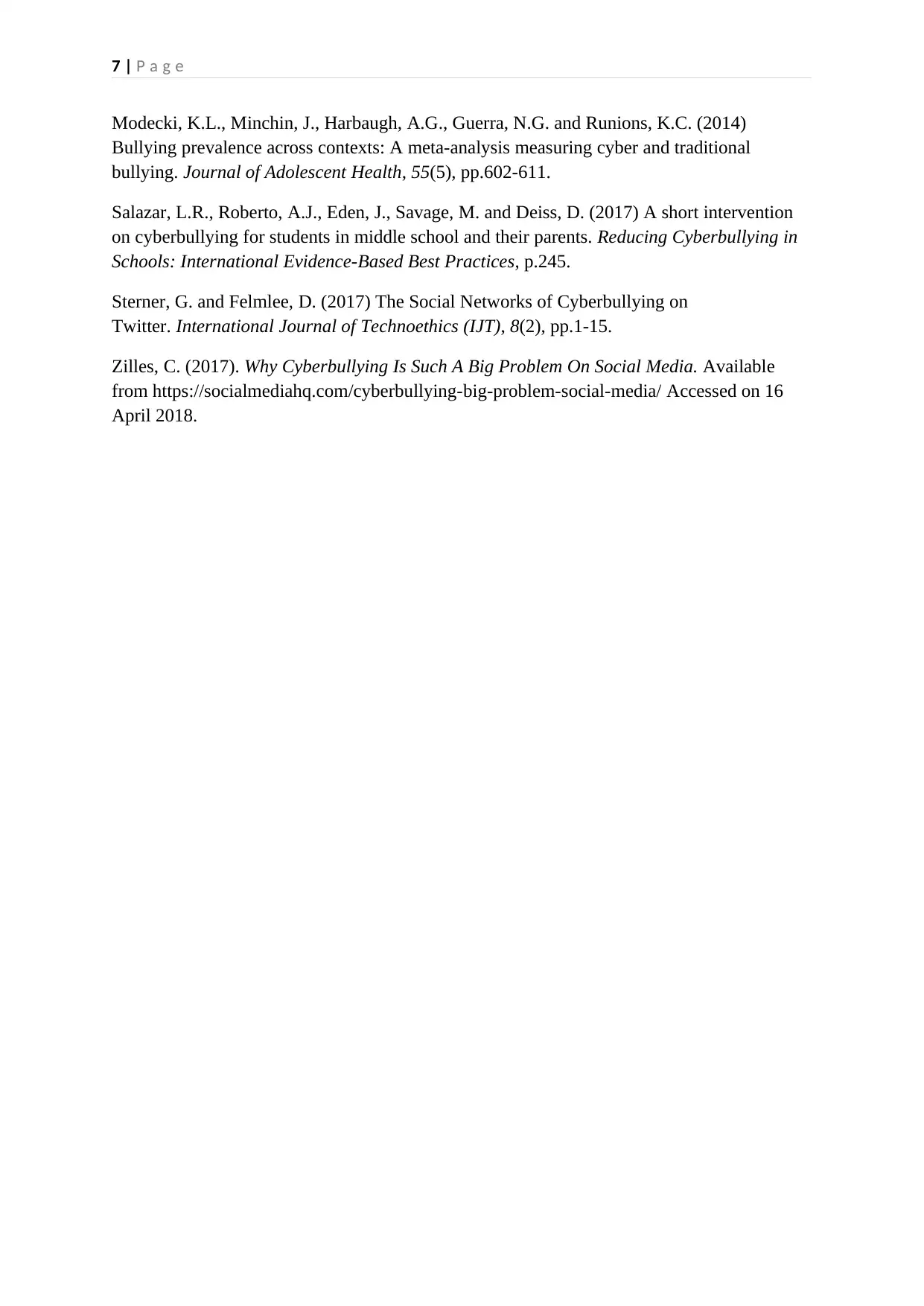
7 | P a g e
Modecki, K.L., Minchin, J., Harbaugh, A.G., Guerra, N.G. and Runions, K.C. (2014)
Bullying prevalence across contexts: A meta-analysis measuring cyber and traditional
bullying. Journal of Adolescent Health, 55(5), pp.602-611.
Salazar, L.R., Roberto, A.J., Eden, J., Savage, M. and Deiss, D. (2017) A short intervention
on cyberbullying for students in middle school and their parents. Reducing Cyberbullying in
Schools: International Evidence-Based Best Practices, p.245.
Sterner, G. and Felmlee, D. (2017) The Social Networks of Cyberbullying on
Twitter. International Journal of Technoethics (IJT), 8(2), pp.1-15.
Zilles, C. (2017). Why Cyberbullying Is Such A Big Problem On Social Media. Available
from https://socialmediahq.com/cyberbullying-big-problem-social-media/ Accessed on 16
April 2018.
Modecki, K.L., Minchin, J., Harbaugh, A.G., Guerra, N.G. and Runions, K.C. (2014)
Bullying prevalence across contexts: A meta-analysis measuring cyber and traditional
bullying. Journal of Adolescent Health, 55(5), pp.602-611.
Salazar, L.R., Roberto, A.J., Eden, J., Savage, M. and Deiss, D. (2017) A short intervention
on cyberbullying for students in middle school and their parents. Reducing Cyberbullying in
Schools: International Evidence-Based Best Practices, p.245.
Sterner, G. and Felmlee, D. (2017) The Social Networks of Cyberbullying on
Twitter. International Journal of Technoethics (IJT), 8(2), pp.1-15.
Zilles, C. (2017). Why Cyberbullying Is Such A Big Problem On Social Media. Available
from https://socialmediahq.com/cyberbullying-big-problem-social-media/ Accessed on 16
April 2018.
1 out of 8
Related Documents
Your All-in-One AI-Powered Toolkit for Academic Success.
+13062052269
info@desklib.com
Available 24*7 on WhatsApp / Email
![[object Object]](/_next/static/media/star-bottom.7253800d.svg)
Unlock your academic potential
Copyright © 2020–2025 A2Z Services. All Rights Reserved. Developed and managed by ZUCOL.





